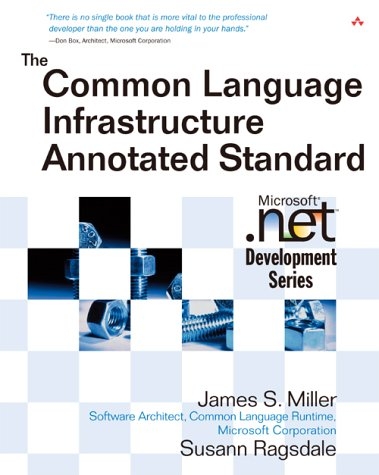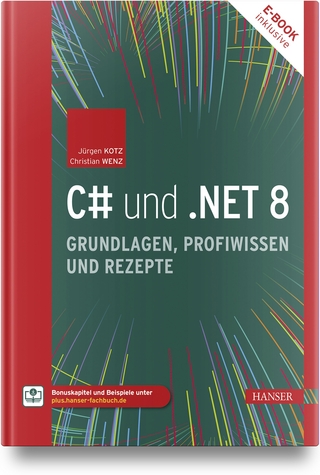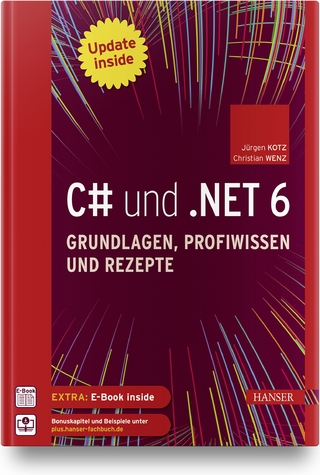
The Common Language Infrastructure Annotated Standard
Addison-Wesley Educational Publishers Inc (Verlag)
978-0-321-15493-4 (ISBN)
- Titel ist leider vergriffen;
keine Neuauflage - Artikel merken
The beating heart of the .NET Framework is the Common Language Runtime (CLR), which manages the loading and execution of all code running on the platform, provides key enabling services such as JIT compilation, garbage collection, exception management, the security model, debugging and profiles support, native platform integration and much, much more. The CLR is an implementation of the Common Language Infrastructure (CLI), an international standard ratified by the European Computer Manufacturers Association (ECMA), and is the first and most significant implementation of the CLI. This book specifies how the system goes together, and is indispensible for anyone who wants to understand the CLI or CLR. The many annotations explain and expand on the original standard, clarifying it and connecting the dots to make the system understandable. These annotations are direct from the ECMA CLI team and the Microsoft CLR team, and are available nowhere else. There is truly no competition out - or expected - for this book.
James S. Miller serves as software architect of the Microsoft team that developed the CLR and as the editor of the ECMA and ISO Common Language Infrastructure (CLI) Standards. Prior to joining Microsoft he was part of the World Wide Web Consortium’s senior management team and served on the research staffs of the Massachusetts Institute of Technology (MIT) Artificial Intelligence Lab, the MIT Lab for Computer Science, Digital Equipment Corporation, and the Open Software Foundation. He earned his Ph.D. in computer science from MIT and has been a member of the Brandeis University faculty. Susann Ragsdale was the original documentation manager for the CLR team, and currently is a consulting technical writer. Before the CLR, she was a lead writer for COM (Microsoft’s Component Object Model). This followed a long and diverse career in consulting on multiprocessor supercomputers, simulation systems, test systems, and integrated circuits. 0321154932AB09182003
Tables.
Foreword.
Preface.
Acknowledgments.
1. Introduction to the Common Language Infrastructure.
Components of the CLI.
The Common Type System.
The Common Language Specification.
Metadata.
Execution and Deployment Models.
Metadata and the File Format.
The Virtual Execution System.
The Standard Framework.
2. Partition I: Concepts and Architecture.
Standard 1. Scope.
Standard 2. Conformance.
Standard 3. References.
Standard 4. Conventions.
Standard 5. Glossary.
Standard 6. Overview of the Common Language Infrastructure.
Standard 7. Common Language Specification (CLS).
Standard 8. Common Type System.
Standard 9. Metadata.
Standard 10. Name and Type Rules for the Common Language Specification.
Standard 11. Collected CLS Rules.
Standard 12. Virtual Execution System.
3. Partition IIA: Metadata Semantics.
Standard 1. Scope.
Standard 2. Overview.
Standard 3. Validation and Verification.
Standard 4. Introductory Examples.
Standard 5. General Syntax.
Standard 6. Assemblies, Manifests, and Modules.
Standard 7. Types and Signatures.
Standard 8. Visibility, Accessibility, and Hiding.
Standard 9. Defining Types.
Standard 10. Semantics of Classes.
Standard 11. Semantics of Interfaces.
Standard 12. Semantics of Value Types.
Standard 13. Semantics of Special Types.
Standard 14. Defining, Referencing, and Calling Methods.
Standard 15. Defining and Referencing Fields.
Standard 16. Defining Properties.
Standard 17. Defining Events.
Standard 18. Exception Handling.
Standard 19. Declarative Security.
Standard 20. Custom Attributes.
4. Overview of File Format.
What Is in Partition IIB (Chapter 5).
Overview of the PE File Format for CLI Files.
Overview of Metadata Physical Layout in PE Files.
Metadata Logical Layout (Sections 21 and 22).
Annotated Dump of a Tiny PE File.
MS-DOS Header.
PE File Header.
PE Section Headers.
Import Address Table.
CLI Header.
Method Header and CIL.
Metadata Root.
Metadata Stream Headers.
The #~ Stream.
String Heap.
Guid Heap.
Blob Heap.
Import Table.
Relocation Section.
5. Partition IIB: Metadata File Format.
Standard 21. Metadata Logical Format: Tables.
Standard 22. Metadata Logical Format: Other Structures.
Standard 23. Metadata Physical Layout.
Standard 24. File Format Extensions to PE.
6. Partition III: CIL Instruction Set.
Standard 1. Scope.
Standard 2. Prefixes to Instructions.
Standard 3. Base Instructions.
Standard 4. Object Model Instructions.
7. Partition IV: Profiles and Libraries.
Standard 1. Overview.
Standard 2. Libraries and Profiles.
Standard 3. The Standard Profiles.
Standard 4. Kernel Profile Feature Requirements.
Standard 5. The Standard Libraries.
Standard 6. Implementation-Specific Modifications to the System Libraries.
Standard 7. Semantics of the XML Specification.
8. Partition V: Annexes.
Annex A. Scope.
Annex B. Sample Programs.
Annex C. CIL Assembler Implementation.
Annex D. Class Library Design Guidelines.
Annex E. Portability Considerations.
Appendix: Microsoft Portable Executable and Object File Format Specification.
1. General Concepts.
2. Overview.
3. File Headers.
4. Section Table (Section Headers).
5. Other Contents of the File.
6. Special Sections.
7. Archive (Library) File Format.
8. Import Library Format.
Appendix: Example Object File.
Appendix: Calculating Image Message Digests.
Glossary.
References.
Index. 0321154932T10202003
| Erscheint lt. Verlag | 6.11.2003 |
|---|---|
| Verlagsort | New Jersey |
| Sprache | englisch |
| Maße | 185 x 235 mm |
| Gewicht | 1558 g |
| Themenwelt | Mathematik / Informatik ► Informatik ► Netzwerke |
| Informatik ► Programmiersprachen / -werkzeuge ► NET Programmierung | |
| ISBN-10 | 0-321-15493-2 / 0321154932 |
| ISBN-13 | 978-0-321-15493-4 / 9780321154934 |
| Zustand | Neuware |
| Haben Sie eine Frage zum Produkt? |
aus dem Bereich


